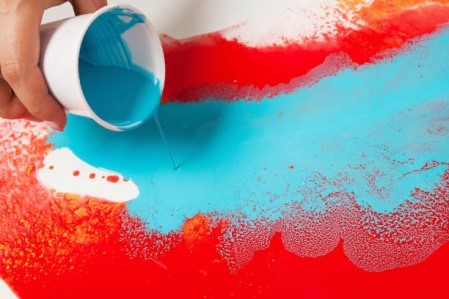In the world of art, an amazing technique called acrylic pouring mixes science and creativity to make mesmerizing masterpieces.
This unique form of abstract art has become popular recently, capturing the interest of artists and art lovers everywhere with its unpredictable and stunning results.
Acrylic pouring involves blending different paint colors and manipulating how they flow on the canvas. It’s like magic with colors! Artists use the alchemy of hues to create captivating and awe-inspiring artworks.
The origins of acrylic pouring can be traced back to recent years when artists began exploring new ways to express their creativity. With this technique, they have found a new world of possibilities to unleash their imagination.
The process of acrylic pouring is quite fascinating. Artists mix acrylic paint with special pouring mediums to create a smooth, fluid consistency. When poured onto the canvas, it allows the paint to flow and interact in mesmerizing ways.
The real charm of acrylic pouring lies in its unpredictability. As the colors mix and mingle, they create unique patterns and textures that cannot be replicated. It’s like watching a beautiful dance of colors on the canvas!
So, if you love colors, creativity, and surprises, acrylic pouring might be the perfect art form to explore. Dive into this magical world of colors, and you’ll be amazed at the captivating masterpieces you can create!
The Origins Of Acrylic Pouring
Acrylic pouring, also known as fluid art or liquid art, has its roots in the 1930s when Mexican artist David Alfaro Siqueiros experimented with pouring paint directly onto canvases.
However, it was in the 1960s and 1970s that acrylic pouring gained traction as an art form.
Pioneered by artists like Helen Frankenthaler and Morris Louis, the technique involved diluting acrylic paints with various pouring mediums to create flowing, translucent layers on canvases.
The process allowed the colors to blend and interact, giving birth to a mesmerizing, organic, and vibrant visual experience.

The Science Behind Acrylic Pouring
At its core, acrylic pouring is a fascinating interplay of physics and chemistry. The fluid dynamics of how different colors mix and flow can be attributed to viscosity, density, and surface tension principles.
Artists manipulate these properties by adjusting the consistency of acrylic paints with pouring mediums, water, or additives.
Pouring mediums act as a binder, reducing the viscosity of the paint while enhancing its flow. Additionally, artists can use silicone oil or alcohol to create mesmerizing cell formations within the artwork.
Cells are small, round shapes forming on the surface as the colors interact, creating a striking contrast between the pigments.
The Basic Techniques Of Acrylic Pouring
Acrylic pouring offers diverse techniques that artists can explore to achieve stunning visual effects. These acrylic pouring techniques leverage the fluidity of acrylic paints and the interplay of colors to create mesmerizing compositions.
The Swipe Technique:
In this method, the artist pours different paint colors onto the canvas and then uses a palette knife or a swipe tool to drag the colors across the surface. It creates a beautiful blending effect, with the underlying colors peeking through the top layer.
The Dirty Pour Technique:
Artists employ the dirty pour technique by layering multiple paint colors in a single container and then pouring them onto the canvas simultaneously. The colors mix and blend as they flow, creating captivating and harmonious compositions.
The Tree Ring Pour:
This technique involves pouring the paint in circular patterns, creating stunning tree ring-like patterns with unique color interactions.
The Dutch Pour:
In these paint pouring techniques, the artist tilts the canvas while pouring the paint, allowing the colors to flow and interact in intriguing ways, often resulting in captivating abstract landscapes.
The Importance Of Intuition And Experimentation
One of the most fascinating aspects of acrylic pouring is the element of unpredictability.
Unlike traditional painting, where the artist exercises more control over the outcome, fluid art relies heavily on intuition and experimentation.
Artists embrace the unexpected and embrace the fluidity of the paint to guide their creative process.
The beauty of acrylic pouring lies in its ability to surprise and delight the artist and the audience, making each piece unique.
Acrylic Pouring As Therapeutic Expression
Pouring and watching colors flow freely allows artists to release stress and anxiety, entering a state of flow and mindfulness.
Engaging in this form of art helps individuals express emotions and thoughts abstractly and non-restrictively, fostering a deeper connection with the creative self.
Conclusion
Acrylic pouring has undoubtedly emerged as a transformative force in the art world, captivating artists and art enthusiasts with its magical alchemy of hues.
The combination of science and creativity in this fluid art form is awe-inspiring, pushing the boundaries of traditional painting and paving the way for new and innovative artistic expressions.
As more artists embrace the fluidity of acrylic pouring and its therapeutic benefits, we can look forward to an even more colorful and captivating world of abstract art in the future.
So, grab your pouring mediums, mix your paints, and embark on an enchanting journey into the alchemy of hues.
